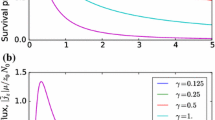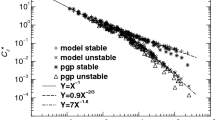Summary
The problem of the diffusion of particulate matter from an elevated source is important to industry, to agriculture and to public health. On the experimental and theoretical side, simple ground measurements of this phenomenon offer very sensitive tests of diffusion theories.
A theoretical solution to this problem, using theK-theory formulation byDeacon [1], but valid only for neutral stability, was given byRounds [2] in 1955 and has been extended by approximate methods to cover any stability by the present author. Calculations then show the dependence of down-wind distribution of deposited matter on stability, surface roughness, height of source, wind speed and particle size. The effects on the location and magnitude of maximum deposition produced by simultaneous variations in two or more of the above parameters are also portrayed.
The formulation bySutton [3] of the statistical theory (theC-theory) has been applied to particulate diffusion by numerous authors, who give differing solutions largely as a result of inconsistent boundary assumptions. A formally correct solution is derived, but a fundamental reexamination of the turbulence mechanism described by theC-theory reveals that this theory is probably not applicable to diffusion from an elevated source near the ground (although it may give essentially the correct ground concentration for gaseous aerosols). In addition, theK-theory has a decided advantage for practical application in that all the parameters required are inherent in the vertical profile of wind speed.
Zusammenfassung
Das Problem der Diffusion suspendierter Partikel von einer Quelle in der Höhe besitzt Bedeutung für Industrie, Landwirtschaft und öffentliche Hygiene. Von experimenteller und theoretischer Seite bieteń schon einfache Bodenmessungen dieses Vorganges sehr empfindliche Prüfmöglichkeiten für Diffusionstheorien.
Eine theoretische Lösung dieses Problems, die auf derK-Theorie-Formulierung vonDeacon [1] beruht, jedoch nur für neutrale Stabilität Gültigkeit besitzt, wurde vonRounds [2] 1955 angegeben und wurde vom Verfasser der vorliegenden Arbeit durch Näherungsmethoden auf beliebige Stabilitätsbedingungen ausgedehnt. Berechnungen haben ergeben, daß die Abhängigkeit der Verteilung der Abwärtsströmungen der abgelagerten Materie von der Stabilität, der Bodenrauheit, der Höhe des Ausgangspunktes, der Windgeschwindigkeit und der Partikelgröße abhängig ist. Die Wirkungen, die durch gleichzeitige Variation von zwei oder mehr der genannten Parameter auf die Lokalisierung und das Ausmaß der maximalen Ablagerung hervorgerufen werden, konnten ebenfalls dargestellt werden.
Suttons [3] Formulierung der statistischen Theorie (C-Theorie) wurde von zahlreichen Forschern auf die Partikeldiffusion angewendet, die im wesentlichen infolge unvereinbarer Grenzvoraussetzungen zu verschiedenartigen Lösungen gekommen sind. Es wird eine formell korrekte Lösung aufgestellt; doch ergibt eine auf die Grundtatsachen zurückgehende Überprüfung des Turbulenzmechanismus, wie er von derC-Theorie formuliert wird, daß diese Theorie wahrscheinlich nicht auf den Vorgang der Diffusion von einem erhöhten Ausgangspunkt in der Nähe des Bodens anwendbar ist (wenn sie auch in den Grundzügen in der Lage ist, die korrekte Bodenkonzentration für gasförmiges Aerosol wiederzugeben). Zudem hat dieK-Theorie einen entschiedenen Vorzug für die praktische Anwendung durch den Umstand, daß alle erforderlichen Parameter im Vertikalprofil der Windgeschwindigkeit enthalten sind.
Résumé
Le problème de la diffusion de particules en suspension issues d'une source en altitude revêt une certaine importance pour l'industrie, l'agriculture et l'hygiène publique. Du point de vue expérimental et théorique, même des mesures au sol de ce phénomène offrent de fines possibilités de vérification des théories de la diffusion.
La solution de ce problème fondée sur la théorie deDeacon [1], mais qui ne vaut que pour une stabilité neutre, a été donnée parRounds [2] en 1955 et a été étendue par l'auteur à d'autres conditions quelconques de stabilité par des méthodes d'approximation. Le calcul montre que les courants descendants de particules dépendent de la stabilité, de la rugosité du sol, de l'altitude de la source, de la vitesse du vent et de la grosseur des particules. L'auteur a pu aussi apprécier l'effet des paramètres variables mentionnés sur la localisation et le dépôt maximum.
De nombreux chercheurs ont appliqué la théorie deSutton à la diffusion des particules et ont abouti à diverses solutions, en raison probablement de conditions aux limites incompatibles. L'auteur établit une formule correcte; mais l'examen du mécanisme de turbulence tel qu'il est formulé dans la théorie deSutton [3] montre que cette dernière n'est probablement pas applicable au voisinage du sol dans le cas d'une diffusion ayant sa source en un point élevé, bien qu'elle puisse fournir la concentration correcte dans le cas d'un aérosol gazéiforme. En outre la théorie deDeacon présente un net avantage pour les applications, du fait que tous les paramètres nécessaires sont contenus dans le profil vertical de la vitesse du vent.
Similar content being viewed by others
References
Deacon, E. L.: Vertical Diffusion in the Lowest Layers of the Atmosphere. Quart. J. Roy. Met. Soc.75, 89–103 (1949).
Rounds, W., Jr.: Solutions of the Two-dimensional Diffusion Equations. Trans. Amer. Geoph. Union36, 395–405 (1955).
Sutton, O. G.: The Theoretical Distribution of Airborne Pollution from Factory Chimneys. Quart. J. Roy. Met. Soc.73, 426–436 (1947).
Taylor, G. I.: On the Theory of Diffusion by Continuous Movements. Proc. Lond. Math. Soc.20, 196–212 (1922).
Sutton, O. G.: The Problem of Diffusion in the Lower Atmosphere. Quart. J. Roy. Met. Soc.73, 257–276 (1947).
Sutton, O. G.: The Application to Micrometeorology of the Theory of Turbulent Flow over Rough Surfaces. Quart. J. Roy. Met. Soc.75, 335–350 (1949).
Csanady, G. T.: Dispersal of Dust Particles from Elevated Sources. Austral. J. Phys.8, 545–550 (1955).
Baron, F., E. R. Gerhard, andH. F. Johnstone: Dissemination of Aerosol Particles Dispersed from Stacks. Ind. Engng. Chem.41, 2403–2408 (1948).
U. S. Weather Bureau: Meteorology and Atomic Energy. Washington: U. S. Government Printing Office, 92–93 (1955).
Hay, J. S., andF. Pasquill: Measurements of the Short Range Diffusion of Airborne Particles at a Height of a Few Hundred Feet in the Atmosphere. Porton Technical Paper 561 (1956).
Watson, H. H.: Diffusion in the Vertical of Smoke Emitted at a Height of 15 m above the Prairie. Suffield Techn. Note 20 (1956).
Author information
Authors and Affiliations
Additional information
Published by permission of the Director, Meteorological Branch, Department of Transport, Canada, and dedicated to Dr.Anders K. Ångström on the occasion of his 70th birthday.
Rights and permissions
About this article
Cite this article
Godson, W.L. The diffusion of particulate matter from an elevated source. Arch. Met. Geoph. Biokl. A. 10, 305–327 (1958). https://doi.org/10.1007/BF02247146
Published:
Issue Date:
DOI: https://doi.org/10.1007/BF02247146




